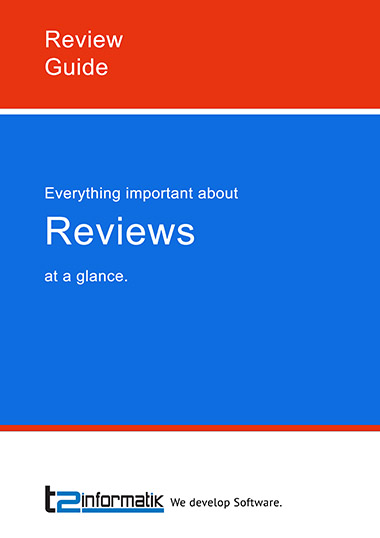Smartpedia: In companies, a review usually refers to a recap of processes, development phases, tools, work results or products.
Review – one term, many meanings
Review is a term with many different meanings and application situations. It can be
- a recap or overview,
- an examination or re-examination,
- a report,
- a meeting or discussion,
- an evaluation,
- a critique,
- an investigation or
- an assessment.
The term is used in product development and evaluation, project management, journalism, literature, education, medical technology and the military. Internal company reviews refer to the examination of processes, development phases, work equipment, work results or products.
Examples of internal company reviews
In companies, there are various disciplines and areas in which reviews are common. Here are some examples:
- A Code Review is a systematic examination of source code with the aim of finding errors and defects in the code and/or improving the quality of the code and thus of the software. It is hence a measure for quality assurance of software development.
- A Sprint Review is a meeting of the Scrum team with important stakeholders at the end of a sprint to assess the completed work in relation to the set sprint goal.
- An After Action Review is an exchange of stakeholders after an action with the aim of reflecting on this action in order to perform future actions even “better”.
- A Project Review is an assessment of a completed project phase or project. The aim is to learn from the past in order to make projects even better in the future.
- A Product Review is an evaluation of a product and serves to identify deficiencies, errors, inconsistencies and optimisation possibilities. It is used as an instrument in product development as well as in product marketing.
Reviews thus usually refer to the procedure (e.g. processes, workflows or tools), the cooperation of those involved (interactions and individuals), the working materials (specifications, customer specifications, user manuals, etc.) or the work results (increments and products).
Objectives of reviews
There are also a number of objectives for reviews:
- The selective, short-term and continuous enhancement of quality with regard to the cooperation of those involved, the concrete procedure, the work tools used and the realised work results.
- The determination of a status as proof of a defined product quality or process quality. This often takes place as a formal audit, with a certificate confirming the quality.
- The informal exchange between team members in the course of product development, e.g. by means of walkthroughs or peer ratings.
- …
The process of a review
The process of a review can be divided into four or five phases:
- In the preparatory phase, administrative tasks – the selection of participants, scheduling, duration and location of the exchange, clarification of specific objectives, and information gathering – are carried out. Some publications prescribe information gathering as a joint activity in the course of the meeting. It is important that organisations identify the most appropriate approach for them.
- After the moderator welcomes the participants, a possible round of introductions, the naming of the concrete goals, the explanation of the agenda and the naming of the time box, the presentation of information, work results, increments, impediments, etc. follows. Here, too, it is important to establish a procedure that fits the organisation and the purpose of the exchange. For example, if it is an acceptance with stakeholders, it probably makes a lot of sense to demonstrate new functions or features on the product and not only via PowerPoint slides.
- This is followed by discussion and evaluation of the information presented. In this phase, the moderator usually becomes particularly active: the aim is to develop a common assessment, to promote an exchange at eye level, to consider different perspectives and to jointly gain insights. These insights are the basis for defining possible measures.
- Finally, the definition and prioritisation of measures, the definition of the next activities and the documentation of the agreements follow.
The documentation of the agreements is often neglected in practice, but it is essential for a possible 5th phase: the alignment of the agreements at the beginning of the next review.
Do you think about a review as a tool for establishing a status quo or a planning tool in disguise?
Notes:
If you like the article or would like to discuss it, please feel free to share it in your network. And if you have any comments, please do not hesitate to send us a message.
Here you will find an experience report on the implementation of a Sprint Review in Large-Scale Scrum (LeSS).
And here you will find additional information from our Smartpedia section:




